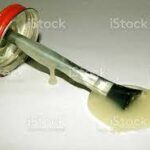
Hydrogen Peroxide and bleach are two chemical substances a home should never lack because they are a present help in time of need.
What is Hydrogen Peroxide?
Hydrogen Peroxide is an inorganic compound represented by the formula H2O2. When in its unrefined state, it has an azure colour. It serves as a disinfectant, oxidizer, germicidal, and bleaching agent. The hydrogen peroxide used in homes is diluted in water, while industries make use of high concentrations.
Uses of Hydrogen Peroxide
Hydrogen Peroxide can be used for many reasons. Apart from home surfaces, it is used on the skin, mouth, teeth, hair and ear. Some of its many uses include:
- For Cleaning Dishwashers: Dish washers are usually contaminated with fungi, especially black yeast, which is dangerous to our health. To eliminate yeast or any form of bacteria or fungi, after cleaning your dishwasher, put some Hydrogen peroxide in a spray bottle and spray it onto the surface of the dishwasher and leave it for sometime before rinsing with water.
- Teeth care and protection; Hydrogen Peroxide cleanses and whitens the teeth. It gradually clears stains that occur on the tooth. It also prevents tooth diseases and infection. Dilute a table spoon of Hydroxy peroxide in 2-3 tablespoons of water. Use it to rinse your mouth. Make sure not to swallow it in the process. It can be harmful to the stomach. Do not overuse it either. Use it 2-3 times a week.
- Helps to grow a healthy garden: Administering three percent of Hydrogen Peroxide can help you grow a healthy garden. It also helps to treat fungus that grows in plants. You should use 6 percent of Hydrogen Peroxide and spray it over the entire garden. Hydrogen Peroxide of 10 percent can kill weeds.
- Cleaning kitchen sinks: If you don’t like the look stains give to your sink or your sink doesn’t look neat and shiny. All you have to do is apply three percent of H2O2 to entire surface. Leave it for 3-5 minutes before rinsing it. This is after you have washed your sink.
- Cleaning and disinfecting toilets and bathroom: Hydrogen Peroxide is a whitening agent and can be used for cleaning toilets. It also kills bacteria, virus, fungi that can cause skin and toilet infections. If you share your toilet with people you don’t trust , just apply three percent of Hydrogen Peroxide and allow it to sit for 8-10 minutes. This will remove any germs deposited by the previous user.
- Treatment of earwax: Earwax is a trouble that almost everyone has to face. To stop itchy ear caused by ear wax, dilute a spoon of Hydrogen Peroxide with 2-3 spoons of water..
- Prevention and cure of nail fungus and discolouration: Hydrogen Peroxide prevents the growth of nail fungus and destroys anyone present. After applying H2O2, some get result instantly while some get result in a week. H2O2 increases the oxygen level in your nails, therefore terminating the fungus.
- Sanitization of pest: If you have a pet it is proper you disinfectant its plate with Hydrogen Peroxide. H2O2 can also remove dried pet waste from your cement or wood floor.
- Home Treatment: H2O2 is a first aid tool. Cuts, scratches, insect bites can be disinfected by H2O2. Canker sores and acne can be reduced by H2O2, but if you want to use it for acne, perform a patch test on a non-visible area of your body and seek medical advice because H2O2 can irritate the skin.
- Cleaning Glass surfaces: Cleaning mirrors or other glass surfaces with water is not a good option when you run-out of glass cleaner. Use a dilution of H2O2 to clean the mirror and see how it shines.
What is bleach?
Bleach is a substance created solely for the purpose of household and industrial cleaning. It is a combination of Sodium hypochlorite (NaCl), small amount of Sodium hydroxide (NaOH), calcium hypochlorite Ca(Clo)2, Hydrogen peroxide (H2O2). These chemical compounds used in bleach production make it a powerful whitening agent.
Uses of bleach
Bleach, unlike Hydrogen peroxide, is only for external use, but carefulness is required when using bleach externally. The uses include:
- It disinfects and whitens toilet: Bleach kills whatever germs that breeds in your toilet. Apply the bleach in a circular motion and leave it for 10-15 minutes before flushing it.
- It whitens white duvets, sheets, and clothes: Stains in white fabrics are easily removed by bleach. Set your washing machine in the hottest setting. Allow it to be filled with water. Then add some detergent into the machine. For a front-loading washing machine, it will have a dispenser. Pour the bleach into the dispenser. For a top-loading washing machine, allow it to be filled with water first before sprinkling bleach inside the water. Set the washer to a normal strength. After the machine is done. Dry your clothes.
- It prolong the life of flowers: The water in a flower vase needs to be changed daily in order to prolong the life of the flower. This can be a heck of a work. With bleach, you can leave the vase water for 3-4 days. It will still be clear and the flowers fresh. Dilute a cup of bleach with 4 cups of water and pour it into the vase.
- It kills the growth of microorganisms: Molds and mildews can be killed by bleach. Apply raw bleach to the surface to eliminate them.
- It eliminate weeds: Avoid the stress of removing weeds like moss, algae e.t.c. Apply raw bleach to the weed.
- It disinfect’s plastic toys: Toys are usually contaminated with germs and require sanitization. Children sometimes put toys inside their mouth so sanitization is a must. To clean the toys, dilute a cup of bleach in 2 cups of water. Submerge the toys in this solution for 5-10 minutes. Then rinse thoroughly.
- It sanitizes cutting boards: After cleaning your cutting board with detergent, dilute a cup of bleach in 2 cups of water. Clean the surface with this solution. Then, clean it with water.
- Cloth decoration and design: Bleach is used in tie-dye. This design is absolutely beautiful and simple to do. It is best to use black fabric for this.
Steps to dye a fabric with bleach
- Get a properly ventilated area. This is because bleach has a strong scent.
- Protect your hands with rubber gloves
- Choose a fabric. Black is the best option.
- Do not use polyester fabrics. It won’t work for this.
- Protect the work surface with old clothing.
- Choose a pattern/design. You can either twist the fabric and hold it with rubber bands. Make sure to space the rubber bands 2 inches apart or you can hold the fabric with two fingers and twist it tightly.
- Spray the bleach on the exposed fabric.
Bleach should not be used on metal surfaces because it corrodes metals. It has a poisonous scent that can harm the lungs. So when opening it, distance your nostrils from it.
Conclusion
Clorox bleach is my favourite bleach. It offers 99.9% of disinfection and whitening. In fact, my whole family uses this bleach. So, I urge you to get it. For Hydrogen peroxide, I don’t have a specific brand that I use. I use any Hydrogen peroxide that has a strength of 3%. You can use a higher concentration depending on what you are using it for. The highest strength of Hydrogen peroxide is 35% and this is way too high for household use.









